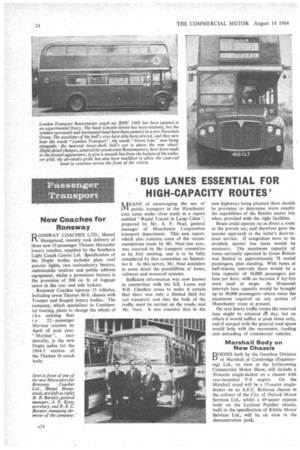'BUS LANES ESSENTIAL FOR • HIGH-CAPACITY ROUTES'
Page 26

If you've noticed an error in this article please click here to report it so we can fix it.
MEANS of encouraging the use of public transport in the Manchester area come under close study in a report entitled "Rapid Transit in Large Cities ", prepared by Mr. A. F. Neal, general manager of Manchester Corporation transport department. This new report, which also contains some of the recommendations made by Mr. Neal last year, was received by the transport committee at its July meeting, and is to be fully considered by that committee on September 8. In this survey, Mr. Neal considers in some detail the possibilities of buses, railways and monorail systems.
Sufficient information was now known in connection with the S.E. Lanes and N.E. Cheshire areas to make it certain that there was only a limited field for rail transport, and that the bulk of the traffic must be carried on the roads, said Mr. Neal. It was essential that in the
new highways being planned there should be provision to determine more exactly the capabilities of the flexible motor bus when provided with the right facilities.
Buses could operate on as direct a route as the private car, and therefore gave the nearest approach to the latter's door-todoor service. If congestion were to be avoided, special bus lanes would be necessary. The maximum capacity of buses currently operated in Great Britain was limited to approximately 78 seated passengers, plus standing. With buses at half-minute intervals there would be a lane capacity of 10,000 passengers per lane per hour, with an increase if lay-bys were used at stops. At 10-second intervals lane capacity would be brought up to 30,000 passengers—about twice the maximum required on any section of Manchester route at present.
On very heavy traffic routes the reserved lane might be retained at day, but on others it would suffice at peak times only, and if merged with the general road space would help with the movement, loading and unloading of commercial vehicles.
Marshall Body on New Chassis
BODIES built by the Omnibus Division of Marshall of Cambridge (Engineering) Ltd., on view at the forthcoming Commercial Motor Show, will include a 50-seater single-decker on a chassis with rear-mounted V-6 engine. On the Marshall stand will be a 53-seater singledecker on an A.E.C. Reliance chassis in the colours of the City of Oxford Motor Services Ltd., whilst a 49-seater express body on the Leyland Panther chassis, built to the specification of Ribble Motor Services Ltd., will be on view in the demonstration park.




















































































































